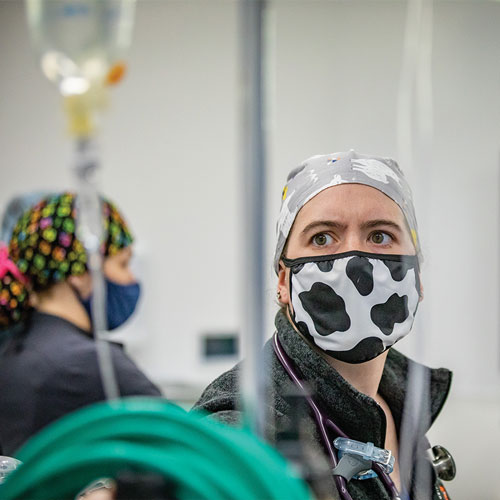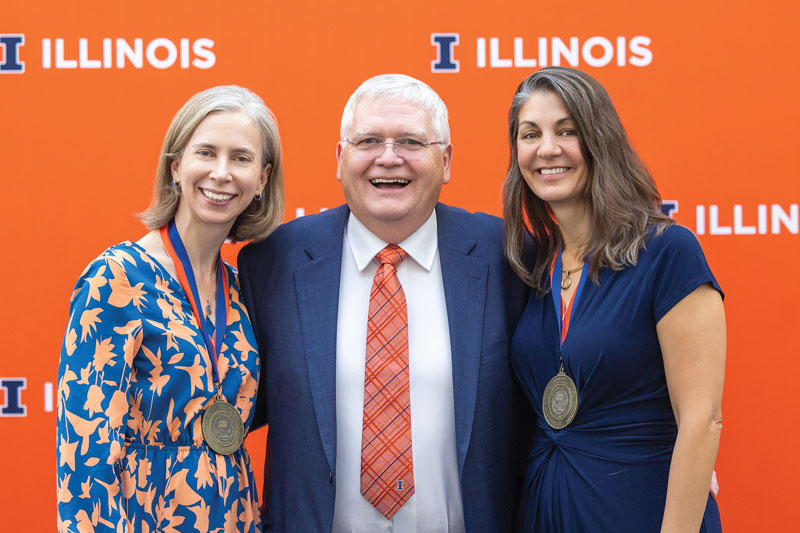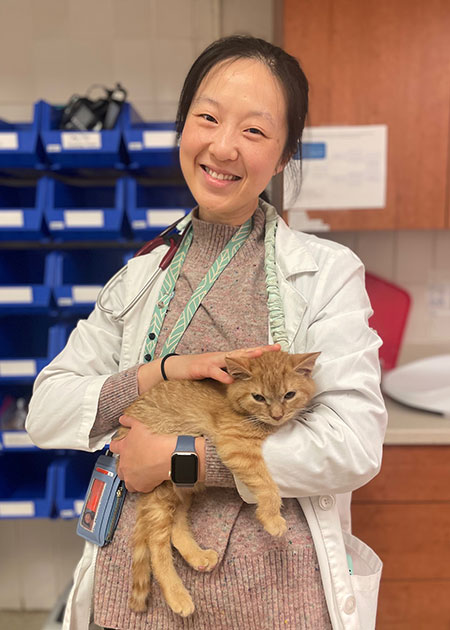Infection Presumed Passed to Tiger from Person
Even when there is no global pandemic, veterinarians are on the front lines in protecting human health, especially when it comes to zoonotic diseases, that is, infections that can cross between people and animals.
The expertise of faculty at the University of Illinois College of Veterinary Medicine positioned them to assist in the rapid identification of SARS-CoV-2, the virus that causes COVID-19 in humans, as the cause of a respiratory illness affecting big cats at the Wildlife Conservation Society’s Bronx Zoo. (Fortunately, the affected animals appear to be recovering from the illness.)
The importance of diagnosing natural SARS-CoV-2 infection in a wild cat cannot be overstated… Many of these species are endangered in the wild, and zoo populations play a critical role in conservation efforts.
Dr. Karen Terio
The key players at Illinois are faculty members in the college’s Veterinary Diagnostic Laboratory:
- Leyi Wang*, a veterinary virologist with expertise in coronaviruses in animals. By March 15, in response to the outbreak, Dr. Wang had created an assay for the rapid detection of the virus. He has received many samples representing species including dog, cat, gorilla, chimpanzee, armadillo, and most recently this tiger. He is the author of the 2016 text Coronaviruses in Animals.
- Karen Terio**, chief of the diagnostic lab’s Zoological Pathology Program (ZPP) and an international leader on medical issues that impact wild cats. A veterinary pathologist at the Bronx Zoo, Dr. Denise McAloose, called Dr. Terio on April 1 to discuss respiratory illness in a big cat under the zoo’s care and to ask about testing options for SARS-CoV-2. Drs. Terio and McAloose were two of three editors who in 2018 published the definitive textbook Pathology of Wildlife and Zoo Animals; Dr. Terio was also the lead author of the book’s the chapter on big cats.
- Rick Fredrickson, director of the Veterinary Diagnostic Laboratory, who coordinated communication with federal authorities. Leaving Urbana at 3 a.m. on April 4, Dr. Fredrickson personally drove the samples from the ill tiger that had tested positive in the Illinois lab to the USDA National Veterinary Services Laboratories (NVSL) in Ames, Iowa. There the Illinois lab’s results were confirmed and the virus was sequenced.
“Veterinarians throughout the zoo and wildlife fields contact colleagues to discuss cases so that we can provide the best possible management for animals in our care,” said Dr. Terio. “ZPP has worked with the Wildlife Conservation Society’s Bronx Zoo veterinary staff to provide diagnostics for other cases in the past, so it was not unusual for us to get a call from them.”
After Wednesday’s conversation between Dr. Terio and Dr. McAloose, samples from a Malayan tiger (oropharyngeal and nasal swabs, tracheal wash) were obtained by veterinarians at the Bronx Zoo and sent to Dr. Wang for molecular testing for SARS-CoV-2. Duplicate samples were also sent to Cornell University, which operates the Animal Health Diagnostic Center in New York state.
Within hours of their arrival at Illinois on April 3, the tiger samples were analyzed. Results showed that all samples tested positive for the virus.
By April 4, the NVSL had confirmed those results.
As required by international agreement, the USDA will be reporting the findings to the World Organisation for Animal Health (OIE). Meanwhile, leaders at the Bronx Zoo conferred with officials at the USDA Animal Plant and Health Inspection Service, the Centers for Disease Control and Prevention (CDC), animal and human health officials in New York City and the state of New York, and the White House Coronavirus Task Force on the possible implications of this first case to be reported in a big cat.
Human and animal health experts agree on the following
- It is presumed that a zoo employee served as the source for the tiger’s infection with the virus.
- Researchers and authorities are constantly learning about the new coronavirus and are evaluating developments to ensure that the most accurate advice is made available to the public.
- There is no evidence that wild or domestic cats have served as a means of transmission of the virus to people.
- It is advisable at this time that pet owners and veterinarians strictly observe hand-washing and other infection-control measures, as outlined by the CDC, when handling animals.
“The importance of diagnosing natural SARS-CoV-2 infection in a wild cat cannot be overstated,” said Dr. Terio. “In my role as a veterinary advisor to the Association of Zoos and Aquariums, I am currently working on guidelines for zoos to help protect cats in our care. Many of these species are endangered in the wild, and zoo populations play a critical role in conservation efforts. At this time, we consider it probable that infections in wild cats will be due to spread from humans.
“Because of these cases, we now know that some species of wild cats are susceptible to SARS-CoV-2 infection and develop clinical disease. But this does not necessarily mean that domestic cats will be getting sick.
“There are a lot more domestic cats that have been exposed to the virus than tigers, so finding it first in a tiger might suggest differences in susceptibility among these cat species. This is not unprecedented, as other viral infections can cause severe and even fatal disease in wild or big cats but not affect domestic cats. We have to remember that they are different species. There are still a lot of unknowns.”
See also:
Feature image by Colin Dengate from Pixabay
More About the Experts
* Since 2013 when Dr. Leyi Wang started his career in veterinary clinical viral diagnosis, he has taken a leading role to protect animal health by identifying and characterizing new coronaviruses of various animal species. He has been the first to report identification of new variant porcine epidemic diarrhea virus (PEDV), porcine deltacoronavirus in diarrheic pigs, novel sparrow deltacoronavirus, new porcine respiratory coronavirus, and new Bottlenose Dolphin coronavirus. From these findings, he has published 17 peer-review papers on coronavirus.
**For more than 10 years Dr. Karen Terio has been a veterinary advisor for the Association of Zoos and Aquariums, including the advisor to the Felid Taxon Advisory Group (the group that manages all wild cats within zoos). She is also an appointed veterinary advisor for multiple wild cat Species Survival Plans.
She is widely recognized as an expert in diseases of wild cats both in zoological institutions and in the wild, having published multiple chapters and journal articles on the subject and served as a veterinary advisor for wild cat conservation programs internationally.

![[malayan tiger]](https://vetmed.illinois.edu/wp-content/uploads/2021/04/tiger-malayan-tiger-4242695.jpg)


